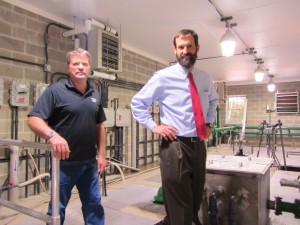
RIGHT: William Janeway, the Adirondack Council’s new executive director, was on hand to offer praise to the Town of Inlet when its new wastewater treatment facility was officially opened in September.
Photo by Gina Greco
The Adirondack Council has released its 2013 State of the Park Report, a 20-page illustrated review of more than 100 actions taken by local, state and federal government officials, that briefly explains what they did to help or hurt the ecology and economy of the Adirondack Park over the past 12 months.
The non-partisan account has been published each October since 1986 as a report card intended to hold government officials accountable.
“The Adirondack Park can be, and should be, the world’s greatest example of how a modern society can live in harmony with nature. Local officials are recognizing more than ever that their communities depend upon the health and beauty of the public Forest Preserve for their survival.
“At the same time, environmental organizations such as the Adirondack Council are recognizing that sustainable, successful communities are vital to the public’s enjoyment of the Adirondack Park and its wild lands and waters, which translates into support for conservation,” said Adirondack Council Executive Director William C. Janeway.
Janeway noted that environmentalists and local governments both lobbied the state government for money to halt invasive species, rebuild water and sewage treatment systems and pay for local planning efforts.
The two sides worked together to gain the State Legislature’s approval for two proposed Constitutional Amendments authorizing land swaps involving the Forest Preserve. Both will appear on the November statewide ballot as Proposition 4 and Proposition 5.
The report highlights four significant judicial decisions in which state and federal Courts won praise for deciding in favor of air pollution regulation, local zoning and the state’s right to protect sections of the Adirondack Park as roadless, motor-free Wilderness.
It also acknowledged the work of other not-for-profit organizations and individuals whose work advanced environmental protection and helped to show that people and nature can thrive together.
They include the Wildlife Conservation Society, The Nature Conservancy, Adirondack Park Invasive Plant Program, Fund for Lake George, Common Ground Alliance, Open Space Institute, Johanson family of Chesterfield, and Champlain Area Trails.
The Adirondack Park is 9,300 square miles, making it the largest park in the contiguous United States.
It is also one of the only American parks designed to include rural villages and towns.
About half of the park’s six million acres are privately owned, dedicated principally to commercial forestry, outdoor recreation, private homes and about 130 rural communities.
The park’s constitutionally protected public lands contain most of the old growth forest and roadless wilderness remaining in the eastern United States.
The Adirondack Council is an independent, privately funded, not-for-profit organization that accepts no public money or taxpayer funded donations of any kind.
The Council’s mission is to ensure the ecological integrity and wild character of the Adirondack Park.
The complete report can be found at: www.adirondackcouncil.org.
